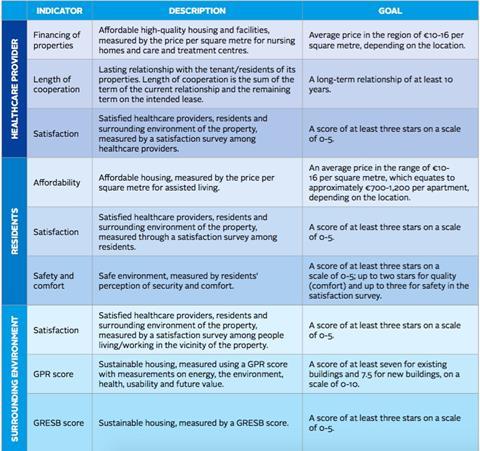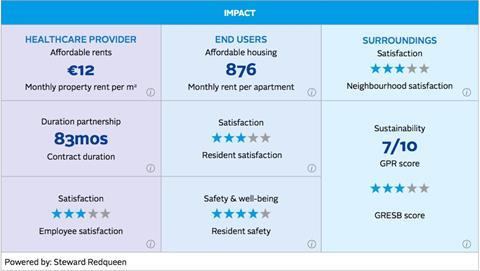Case study by Hartelt Fund Management
- Signatory type: Investment Manager
- Operating region: Netherlands
- Author: Steve Goossens, Associate, Hartelt Fund Management
The number of people aged 65-plus is set to increase by 1.3 million over the next 25 years. With increasing age, elderly citizens will need access to assisted living facilities or nursing homes, but the current supply will not meet future demand.
Three trends are taking place:
- the segregation of housing and care: people with a mild to moderate need for care can live longer at home. If living at home is no longer possible, people will go to a suitable nursing home;
- the need for small-scale housing: demand is rising for a combination of living, care, services and well-being; and
- the decentralisation of healthcare: because people are staying at home longer, demand for a range of specialist care (e.g. multidisciplinary care, treatment centres) in the neighbourhood is increasing.
According to the Economic Institute for Construction, there is an annual need to expand healthcare real estate by 800,000m² each year until 2030 in the Netherlands. This equals an investment and financing demand per year of €1.5 billion as of 2016, rising to an annual requirement of €3.3 billion in 2030.
Fund impact
The Apollo Healthcare Property Fund uses the Theory of Change to identify social goals, how the goals can be achieved, and how to measure success. By measuring the impact from active fund management, the fund satisfies its claim for additionality. The fund initiates and manages long-term partnerships with institutional investors and healthcare providers, focusing on project design, partnerships and investments.
It aims to deliver social impact across three groups, with an expected internal rate of return of 7 percent, before applying leverage (see Figure 1). In our research, we use external market reports, such as from Ecorys, CBRE, the Dutch government, and have discussions with healthcare organisations/providers, residents, architects and healthcare developers.
Healthcare providers (professionals that provide the different types of care in each segment of the fund)
We strongly believe that there is a positive relationship between the financial return and social return of a property. The long-term partnerships and dedication to affordability translate into long-term rental contracts, reducing risks and enabling the fund to achieve competitive yields.
Improved small-scale design ensures efficiency in the day-to-day operation of the care centre (e.g. efficient staff workflow and a logical layout of the building). Modern real estate also has a positive effect on employees; a healthy building with plenty of daylight, climate control and that is well connected to the outside increases the vitality of employees, reduces employee absence and has a positive impact on their effectiveness. Through more efficient operations, caregivers have more time for their residents and patients.

Surrounding environment
The surrounding environment is displayed on the right side of the pyramid in Figure 1; these are both the residents and their relatives in the immediate vicinity. They have a direct interest in modern and appropriate healthcare real estate, which starts with sustainable construction and management. That also means it must be future-proof – in terms of its flexibility to meet changing tenant needs and ability to transform for other purposes.
The fund aims to develop housing that increases social contact and visits by family members. An example is our property in Arnhem, in the development pipeline of the fund. This property will have a community manager available for the residents to organise care, services and improve well-being. The community manager will also stimulate interaction between residents and the neighbourhood (for example, the nearby school will help residents with the community garden).
Residents and users
The main target group of the fund’s impact strategy are the residents and users. In the case of assisted living and nursing homes, these are the residents, and in the case of healthcare centres, these are the clients of the different care disciplines available.
The fund offers residents suitable, affordable housing of high quality and which meets modern (future) requirements and conveniences. Affordability is measured by the price per square metre. The goal is an average price of between €10 and €16 per square metre, depending on the location. For the assisted living segment, this equates to approximately €700-€1,200 per apartment, depending on location and median income.
The fund constructs nursing homes with high-quality noise reduction and enough natural light, which increases the well-being of residents and in turn can reduce their need for sleeping medication. By introducing smaller, shared common rooms in assisted living units, residents experience the feeling of a more traditional living room, which can help to reduce social isolation. The investments in care and treatment centres help healthcare providers to interact and work together to help people with increasingly complex health issues.

Measuring impact
The fund aims to deliver impact in the short and long term (see Figure 1), collecting data for specific indicators on its investments. The results need to be measurable and quantifiable in order to be meaningful. They must also be able to detect change during the period in which the fund invests in an asset. A “zero measurement” is conducted at the start of the investment period followed by annual assessments to record change. The fund currently measures its impact with the indicators presented in Figure 2.
Over the years, new insights will be gained on what data provide the best insight into the impact of the fund and its investments.
Reporting on impact
Through an online dashboard, as displayed in Figure 3, investors can view the fund’s impact reporting metrics.
The goal of the dashboard is to:
- share the impact of institutional investments in healthcare housing and facilities;
- give investors the opportunity to draw conclusions on the results of the fund and to go into more detail on specific investments; and
- be transparent about results.
Some high-level impact indicators are disclosed to the general public. For sensitivity and privacy reasons, lower-level impact ones (segment and property level) are available only to investors.
By presenting data on the impact measurements, the fund seeks to demonstrate that sustainable healthcare is beneficial to residents, healthcare providers and investors.

Download the PDF
-

Affordable housing solutions in the Dutch care business
January 2019
Downloads
Case study: Affordable housing solutions in the Dutch care business
PDF, Size 0.19 mb













